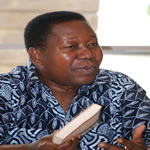ROFFEKE: You could have chosen to animate something that portrayed lighter themes but “in quanto a noi” (From our side) is about “sixty years of Italian History flow, taking us from one darkness to another”. What is the importance of highlighting darker themes, especially from historical events?
SIMONE MASSI: I could have chosen to talk about lighter themes, it's true, but this is the path I chose from the beginning. The first short film made at school, just under thirty years ago, told the story of the Resistance and fascism. I believe I was the first in Italy to address these issues and I made this choice with awareness of the difficulties and risks. Animated cinema should be a worthy heir to painting, to the studies of Renaissance painters. And they told stories and not jokes.
ROFFEKE: In the 2013 interview by Golden Kuker Sofia regarding a career as an animator, you said that you chose “a difficult job”. Animation is challenging and time-consuming but what are some of the advantages, highlights and fun aspects of being an animator?
SIMONE: There are mainly two advantages: freedom
and being able to do a job that I love. How many can say the same thing?
ROFFEKE: In the same 2013 interview, you say you’ve been an animator since 1995. What would you say are the main differences between animation in 1995 and animation in 2024?
SIMONE: In my opinion there are no big differences, I continue to see animation as a splendid opportunity for expression and I continue in the same way, with the sequence shot, the zooms, the metamorphoses... I have taken into account that in the meantime the world is changed a lot and people might see my work as something ancient, out of time.
ROFFEKE: As an animator, what are your views about artificial intelligence and creativity?
SIMONE: What I have noticed is that much of what had been imagined by the writers and directors of science fiction films is coming true. And given that they unanimously prophesied catastrophic scenarios, I cannot hide that I am worried. Throughout its thousand-year history, human beings have never demonstrated wisdom or common sense.
ROFFEKE: Advice for upcoming animators?
SIMONE: I belong to the older generation, which makes everything by hand, without using a computer, it is very difficult to give advice. Instead I have a hope, I hope that upcoming animators try to make their dreams come true without harming others.
ROFFEKE: In these hectic times, how do you take care of your mental health?
SIMONE: I try not to follow the media, not to rush. And then I try to take the good in life, accepting defeat and respecting others.































































































































































































